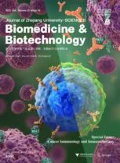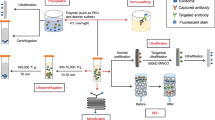Abstract
Exosomes are nanometer-sized vesicles that contain various types of biologically active components, including proteins, nucleic acids, carbohydrates, and lipids, which vary with the type and physiological state of the cell. In recent years, several studies have showed that exosomes can provide new non-invasive diagnostic and prognostic biomarkers in patients affected by cancers, including bladder cancer (BC), and the lipid bilayer membrane structure makes exosomes as promising delivery vehicles for therapeutic applications. Exosomes have the characteristics of high abundance, high stability, tissue specificity, and wide distribution in body fluids, and are secreted as various types by cells in different states, thereby possessing great potential as biomarkers for BC. Herein, we briefly summarize the functions and roles of exosomes in the occurrence and development of BC and the current progress of research on exosomes in BC, while focusing on potential clinical applications of the diagnosis, treatment, and prognosis of BC.
概要
外泌体是纳米大小的囊泡, 包含蛋白质、核酸、碳水化合物和脂质等各种生物活性成分, 这些成分会随细胞的类型和生理状态而变化。近年来, 一些研究表明不但外泌体可以为包括膀胱癌在内的多种肿瘤提供新的无创性诊断和预后生物标志物, 而且外泌体脂质双层膜结构可使其成为治疗应用的理想载体。外泌体具有丰度高、稳定性好、组织特异性强, 以及在体液中广泛分布等特点, 且可以由在不同状态下的多种细胞所分泌。因此, 外泌体具有作为膀胱癌诊断和预后生物标志物的巨大潜力。本文就外泌体在膀胱癌发生发展中的作用及其研究现状进行综述, 并聚焦于外泌体在膀胱癌诊断、治疗和预后中的临床应用。
Similar content being viewed by others
References
Abbastabar M, Sarfi M, Golestani A, et al., 2020. Tumor-derived urinary exosomal long non-coding RNAs as diagnostic biomarkers for bladder cancer. EXCLI J, 19: 301–310. https://doi.org/10.17179/excli2019-1683
Beckham CJ, Olsen J, Yin PN, et al., 2014. Bladder cancer exosomes contain EDIL-3/Del1 and facilitate cancer progression. J Urol, 192(2):583–592. https://doi.org/10.1016/j.juro.2014.02.035
Berrondo C, Flax J, Kucherov V, et al., 2016. Expression of the long non-coding RNA hotair correlates with disease progression in bladder cancer and is contained in bladder cancer patient urinary exosomes. PLoS ONE, 11(1): e0147236. https://doi.org/10.1371/journal.pone.0147236
Cai HZ, Yang XJ, Gao Y, et al., 2019. Exosomal microRNA-9-3p secreted from BMSCs downregulates ESM1 to suppress the development of bladder cancer. Mol Ther Nucleic Acids, 18:787–800. https://doi.org/10.1016/j.omtn.2019.09.023
Cai XX, Qu LL, Yang J, et al., 2020. Exosome-transmitted microRNA-133b inhibited bladder cancer proliferation by upregulating dual-specificity protein phosphatase 1. Cancer Med, 9(16):6009–6019. https://doi.org/10.1002/cam4.3263
Chen CH, Luo YM, He W, et al., 2020. Exosomal long noncoding RNA LNMAT2 promotes lymphatic metastasis in bladder cancer. J Clin Invest, 130(1):404–421. https://doi.org/10.1172/JCI130892
Chen X, Chen RX, Wei WS, et al., 2018. PRMT5 circular RNA promotes metastasis of urothelial carcinoma of the bladder through sponging miR-30c to induce epithelial-mesenchymal transition. Clin Cancer Res, 24(24): 6319–6330. https://doi.org/10.1158/1078-0432.CCR-18-1270
Christensen E, Birkenkamp-Demtröder K, Sethi H, et al., 2019. Early detection of metastatic relapse and monitoring of therapeutic efficacy by ultra-deep sequencing of plasma cell-free DNA in patients with urothelial bladder carcinoma. J Clin Oncol, 37(18):1547–1557. https://doi.org/10.1200/JCO.18.02052
de Palma G, di Lorenzo VF, Krol S, et al., 2019. Urinary exosomal shuttle RNA: promising cancer diagnosis biomarkers of lower urinary tract. Int J Biol Markers, 34(2):101–107. https://doi.org/10.1177/1724600819827023
el Andaloussi S, Mäger I, Breakefield XO, et al., 2013. Extracellular vesicles: biology and emerging therapeutic opportunities. Nat Rev Drug Discov, 12(5):347–357. https://doi.org/10.1038/nrd3978
Elsharkawi F, Elsabah M, Shabayek M, et al., 2019. Urine and serum exosomes as novel biomarkers in detection of bladder cancer. Asian Pac J Cancer Prev, 20(7):2219–2224. https://doi.org/10.31557/APJCP.2019.20.7.2219
Franzen CA, Blackwell RH, Todorovic V, et al., 2015. Urothelial cells undergo epithelial-to-mesenchymal transition after exposure to muscle invasive bladder cancer exosomes. Oncogenesis, 4(8): e163. https://doi.org/10.1038/oncsis.2015.21
Franzen CA, Blackwell RH, Foreman KE, et al., 2016. Urinary exosomes: the potential for biomarker utility, intercellular signaling and therapeutics in urological malignancy. J Urol, 195(5):1331–1339. https://doi.org/10.1016/j.juro.2015.08.115
Huang CS, Ho JY, Chiang JH, et al., 2020. Exosome-derived LINC00960 and LINC02470 promote the epithelial-mesenchymal transition and aggressiveness of bladder cancer cells. Cells, 9(6):1419. https://doi.org/10.3390/cells9061419
Li Q, Wang HL, Peng HR, et al., 2019. MicroRNAs: key players in bladder cancer. Mol Diagn Ther, 23(5):579–601. https://doi.org/10.1007/s40291-019-00410-4
Li Q, Huyan T, Cai SN, et al., 2020. The role of exosomal miR-375-3p: a potential suppressor in bladder cancer via the Wnt/β-catenin pathway. FASEB J, 34(9):12177–12196. https://doi.org/10.1096/fj.202000347R
Liang ZF, Lu L, Mao JH, et al., 2017. Curcumin reversed chronic tobacco smoke exposure induced urocystic EMT and acquisition of cancer stem cells properties via Wnt/β-catenin. Cell Death Discov, 8(10): e3066. https://doi.org/10.1038/cddis.2017.452
Lin F, Yin HB, Li XY, et al., 2020. Bladder cancer cell-secreted exosomal miR-21 activates the PI3K/AKT pathway in macrophages to promote cancer progression. Int J Oncol, 56(1):151–164. https://doi.org/10.3892/ijo.2019.4933
Mearini E, Poli G, Cochetti G, et al., 2017. Expression of urinary miRNAs targeting NLRs inflammasomes in bladder cancer. Onco Targets Ther, 10:2665–2673. https://doi.org/10.2147/OTT.S132680
Miyamoto DT, Mouw KW, Feng FY, et al., 2018. Molecular biomarkers in bladder preservation therapy for muscle-invasive bladder cancer. Lancet Oncol, 19(12): e683–e695. https://doi.org/10.1016/S1470-2045(18)30693-4
Pantel K, Alix-Panabières C, 2010. Circulating tumour cells in cancer patients: challenges and perspectives. Trends Mol Med, 16(9):398–406. https://doi.org/10.1016/j.molmed.2010.07.001
Pegtel DM, Gould SJ, 2019. Exosomes. Annu Rev Biochem, 88:487–514. https://doi.org/10.1146/annurev-biochem-013118-111902
Poli G, Brancorsini S, Cochetti G, et al., 2015. Expression of inflammasome-related genes in bladder cancer and their association with cytokeratin 20 messenger RNA. Urol Oncol Semin Orig Invest, 33(12):505.e1–505.e7. https://doi.org/10.1016/j.urolonc.2015.07.012
Poli G, Cochetti G, Boni A, et al., 2017. Characterization of inflammasome-related genes in urine sediments of patients receiving intravesical BCG therapy. Urol Oncol Semin Orig Invest, 35(12):674.e19–674.e24. https://doi.org/10.1016/j.urolonc.2017.08.004
Poli G, Egidi MG, Cochetti G, et al., 2020. Relationship between cellular and exosomal miRNAs targeting NOD-like receptors in bladder cancer: preliminary results. Minerva Urol Nefrol, 72(2):207–213. https://doi.org/10.23736/S0393-2249.19.03297-1
Ringuette Goulet C, Bernard G, Tremblay S, et al., 2018. Exosomes induce fibroblast differentiation into cancer-associated fibroblasts through TGFβ signaling. Mol Cancer Res, 16(7):1196–1204. https://doi.org/10.1158/1541-7786.MCR-17-0784
Siegel RL, Miller KD, Jemal A, 2019. Cancer statistics, 2019. CA Cancer J Clin, 69(1):7–34. https://doi.org/10.3322/caac.21551
Street JM, Yuen PST, Star RA, 2014. Bioactive exosomes: possibilities for diagnosis and management of bladder cancer. J Urol, 192(2):297–298. https://doi.org/10.1016/j.juro.2014.05.050
Wang JS, Yang K, Yuan WX, et al., 2018. Determination of serum exosomal H19 as a noninvasive biomarker for bladder cancer diagnosis and prognosis. Med Sci Monit, 24:9307–9316. https://doi.org/10.12659/MSM.912018
Wu CH, Silvers CR, Messing EM, et al., 2019. Bladder cancer extracellular vesicles drive tumorigenesis by inducing the unfolded protein response in endoplasmic reticulum of nonmalignant cells. J Biol Chem, 294(9):3207–3218. https://doi.org/10.1074/jbc.RA118.006682
Xue M, Chen W, Xiang A, et al., 2017. Hypoxic exosomes facilitate bladder tumor growth and development through transferring long non-coding RNA-UCA1. Mol Cancer, 16:143. https://doi.org/10.1186/s12943-017-0714-8
Yazarlou F, Mowla SJ, Kholghi Oskooei V, et al., 2018a. Urine exosome gene expression of cancer-testis antigens for prediction of bladder carcinoma. Cancer Manage Res, 10:5373–5381. https://doi.org/10.2147/CMAR.S180389
Yazarlou F, Modarressi MH, Mowla SJ, et al., 2018b. Urinary exosomal expression of long non-coding RNAs as diagnostic marker in bladder cancer. Cancer Manage Res, 10:6357–6365. https://doi.org/10.2147/CMAR.S186108
Yin XB, Zheng XP, Liu M, et al., 2020. Exosomal miR-663b targets Ets2-repressor factor to promote proliferation and the epithelial-mesenchymal transition of bladder cancer cells. Cell Biol Int, 44(4):958–965. https://doi.org/10.1002/cbin.11292
Yoshida K, Tsuda M, Matsumoto R, et al., 2019. Exosomes containing ErbB2/CRK induce vascular growth in premetastatic niches and promote metastasis of bladder cancer. Cancer Sci, 110(7):2119–2132. https://doi.org/10.1111/cas.14080
Zhan Y, Du LT, Wang LS, et al., 2018. Expression signatures of exosomal long non-coding RNAs in urine serve as novel non-invasive biomarkers for diagnosis and recurrence prediction of bladder cancer. Mol Cancer, 17:142. https://doi.org/10.1186/s12943-018-0893-y
Zhang SJ, Du LT, Wang LS, et al., 2019. Evaluation of serum exosomal lncRNA-based biomarker panel for diagnosis and recurrence prediction of bladder cancer. J Cell Mol Med, 23(2):1396–1405. https://doi.org/10.1111/jcmm.14042
Zheng R, Du ML, Wang XW, et al., 2018. Exosome-transmitted long non-coding RNA PTENP1 suppresses bladder cancer progression. Mol Cancer, 17(1): 143. https://doi.org/10.1186/s12943-018-0880-3
Acknowledgments
The present work was supported by the National Natural Science Foundation of China (No. 8157100782), the Natural Science Research in Universities of Anhui Province (No. KJ2018A0209), the Foundation for Excellent Young Teachers of Jiangsu University, Zhenjiang Social Development Guidance Project (No. FZ2019038), the Research and Practice Innovation Program for Graduate Students of Jiangsu Province (No. KYCX20_3089), and the Experimental Animal Center of Jiangsu University, China.
Author information
Authors and Affiliations
Corresponding authors
Additional information
Author contributions
Hao GENG, Qingchen ZHOU, and Zhaofeng LIANG designed research and wrote the paper. Wenhao GUO, Ling LU, Liangkuan BI, Yi WANG, and Jie MIN participated in data collection and analysis. Dexin YU and Zhaofeng LIANG participated in the writing and revisions. All authors have read and approved the final manuscript.
Compliance with ethics guidelines
Hao GENG, Qingchen ZHOU, Wenhao GUO, Ling LU, Liangkuan BI, Yi WANG, Jie MIN, Dexin YU, and Zhaofeng LIANG declare that they have no conflict of interest.
This article does not contain any studies with human or animal subjects performed by any of the authors.
Rights and permissions
About this article
Cite this article
Geng, H., Zhou, Q., Guo, W. et al. Exosomes in bladder cancer: novel biomarkers and targets. J. Zhejiang Univ. Sci. B 22, 341–347 (2021). https://doi.org/10.1631/jzus.B2000711
Received:
Accepted:
Published:
Issue Date:
DOI: https://doi.org/10.1631/jzus.B2000711




